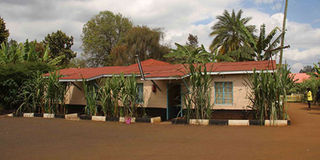Dreaded detention camp turned into school

These houses at Kangubiri Girls High School in Nyeri were used as offices during the colonial era. PHOTO | JOSEPH KANYI | NATION MEDIA GROUP
What you need to know:
- Former Colonial Senior Chief Muhoya Kagumba proposed that the camp be converted into something beneficial to the community.
Aguthi Works Camp in Tetu, Nyeri County, was the final stop for most freedom fighters during the colonial era.
Irrespective of wherever else they had been held, it was here they were either granted freedom or sentenced to death.
Consequently, the locals distorted the words “can go free” to “kangubiri”. But the camp was converted into a school, Kangubiri Girls' High School.
After Kenya gained independence in 1963, former Colonial Senior Chief Muhoya Kagumba proposed that the camp be converted into something beneficial to the community.
His idea saw the camp turned into an institution, now one of the top extra-county schools in the Central region. The chief was the school’s first principal and chairman of board.
The school’s brick buildings have been painted white in line with its colour scheme. Each of the structures in the school’s residential area is surrounded by clusters of bananas and sugarcane.
MASS GRAVE
Four of the buildings served as offices for the colonial officers and their commandant.
But the school now uses them as stores for food, uniforms, agricultural tools, games equipment and a home science laboratory.
At one end of the compound is a structure with no windows, with a barbed wire around the roof, which made it difficult for inmates to escape.
Inside the building are two wooden poles running from wall to wall. This was the torture chamber where the prisoners were hanged if they refused to confess their perceived crimes to the colonial administration.
Detainees were buried in a mass grave inside the camp during the State of Emergency. The area is accessible down a path leading from the main school grounds.
Less than a kilometre from the school is an undocumented mass grave on an half-acre piece of land.
RECREATION SITE
Locals have found human jawbones and skulls on their farms, which they believe to be of Mau Mau fighters.
Next to the main dormitory is a building partitioned into six rooms, which were used as cells. The building, which has been painted green, now serves as a dormitory.
Mr Geoffrey Kariuki, who has worked as a guard at the school for nearly 10 years, said the former cells were converted into a dormitory to provide additional accommodation for the students.
He added that there was a 30-foot trench around the wardens’ offices and the cells to keep the detainees out of the offices and to prevent them from escaping.
Poles were planted in the trench, on which any inmate who tried to escape would be hanged.
Behind the school is a park with many trees, where the colonial officers would rest. The school still uses it for recreation.
SPORTS GROUND
At the school’s entrance is a huge jacaranda tree which, Mr Kariuki said, was uprooted from a forest and grown by African labourers.
Next to the tree is a structure that was used as a watch tower.
On the right, from the entrance, is a pitch that was dug and levelled by Africans for the colonial officers to play hockey.
Today the school uses it as a sports field, with volleyball and badminton courts, and a football pitch.
Is there a site you want us to feature? Write an e-mail to [email protected].





